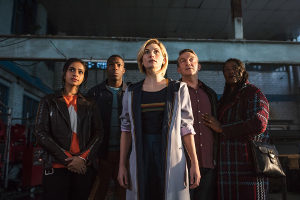Doctor Who and the 13th Doctor: an Analysis
 By Source (WP:NFCC#4), Fair use, https://en.wikipedia.org/w/index.php?...
By Source (WP:NFCC#4), Fair use, https://en.wikipedia.org/w/index.php?...
We are now three episodes in to the new season of Doctor Who where we are introduced to the well-publicized first female regeneration of the 13th Doctor Who, played by Jodi Whitaker. When she was first announced as the Doctor, the decision assured me, as Whitaker delivered a strong performance in Broadchurch. Now, after three episodes, it seems she is fighting an uphill battle and the DW creative crew is doing her no favors. (More on that later.)
Episode One
The first episode, “The Woman Who Fell to Earth,” throws you into the mix of events with little explanation and lots of questions, a good storytelling approach. Jodi’ s Doctor is a flurry of energy (literally) and confusion as she struggles to sort herself out. All of the chattiness and quickly delivered dialogue is very reminiscent of David Tennant’s 10th Doctor, but when she does her own thing, it feels forced, as if she’s trying way too hard to deliver this performance. We have no idea what parameters Chris Chibnall gave Jodi in which to define her character. As Tom Baker put it when he was the Doctor, he received no instruction, so he wasn’t acting, he was being himself. Perhaps we need more Jodi and less of a nebulous idea of who this new Doctor is.
(Spoiler alert coming up! Stop reading if you haven’t seen the second episode yet.)
Episode Two
 By Source (WP:NFCC#4), Fair use, https://en.wikipedia.org/w/index.php?...
By Source (WP:NFCC#4), Fair use, https://en.wikipedia.org/w/index.php?...
The second episode, “The Ghost Monument,” immediately drops the Doctor and her trio of companions into a do or die survival scenario, thus spending much of the time trying to stay alive and not developing the character of the Doctor. Then we discover the true purpose of the journey was to reunite the Doctor with her TARDIS. The whole episode feels like an extension of the first one, or just another step to help put the pieces in place to get the audience where we’re used to being: with the Doctor and her companions in the TARDIS exploring the universe and getting into trouble.
An annoying element about this episode was, as one critic complained, too many dialog along the lines of “Oh, look, a door!” or “A tunnel!” or “That’s a hologram!” (my examples, not actual quotes from the story). Then, after the Doctor says, “Oh look, a locked door, how ominous,” THEY NEVER SHOW THE DOOR. This is perhaps the worst editing I’ve ever seen on a professional production. Every good editor knows you show the audience rather than tell them. So what happened? Did a cameraman forget to film the door? Did the production team forget to build the door? Was this improved on set? This, combined with the completely disjointed scene of the heroes running away from robots shooting laser bolts at them, made for some really bad continuity errors on the part of the editing team.
Episode Three
 By Source (WP:NFCC#4), Fair use, https://en.wikipedia.org/w/index.php?...
By Source (WP:NFCC#4), Fair use, https://en.wikipedia.org/w/index.php?...
In “Rosa,” the third episode, the writing and directing team delivered a sensitive story with a skillful and steady hand. The well written dialog and the underplayed ending really worked for a historical journey to preserve Rosa Parks’ famous protest on a bus in Alabama. I really went into this episode with trepidation, expecting a heavy-handed dose of liberal righteousness. I only cringed once, when seeing the short clip of Bill Clinton awarding Rosa the Congressional Medal of Honor, which had more to do with him, than her.
The ending in which the Doctor explaining everything that happened in Rosa Parks’ life after the bus incident was a bit over the top. Did the Doctor just happen to know this information? If so, why did she seem ignorant of other details earlier in the episode? Did she look up the rest of Rosa’s life in the TARDIS databanks? If so, which would have made for a better scene, why not have her reading about it from a console instead of passionately telling the others their own history?
Looking at the episode technically, what’s the deal with all the extreme close ups? The camera is way too close in many shots, especially when the Doctor faces off against the villain. A close up can create forced intimacy with the audience, but if it’s too close all I can think of is, “Way big face!” and the opposite happens, I distance myself.
Conclusion
Overall, I’m comfortable with the three episodes so far and Jodi is doing an acceptable job, which brings me back to my initial comments about the creative team’s decisions not doing her any favors.
First, if you do a search for Jodi online, you’ll find a ton of photos of her with various hairstyles which really compliment her beauty, but this haircut they gave her for the Doctor is terrible, including the color. I hoped (as was the Doctor, I’m sure) she would have been ginger, as she in Broadchurch.
Second, her outfit is atrocious.
Third, her sonic screwdriver, which luckily they only show briefly, supposedly resembles a spoon, though as many on the internet have pointed out, looks a lot more like something else.
Fourth, the new TARDIS interior has a few cool items, such as the hologram of the police box, but overall it seems very gloomy and cramped in the control room.
On a good note, all the companions are good. I especially enjoy Bradley Walsh’s character, Graham. He consistently delivers a relatable and sensitive character.
The post Doctor Who and the 13th Doctor: an Analysis appeared first on Uncanny Expeditions.



